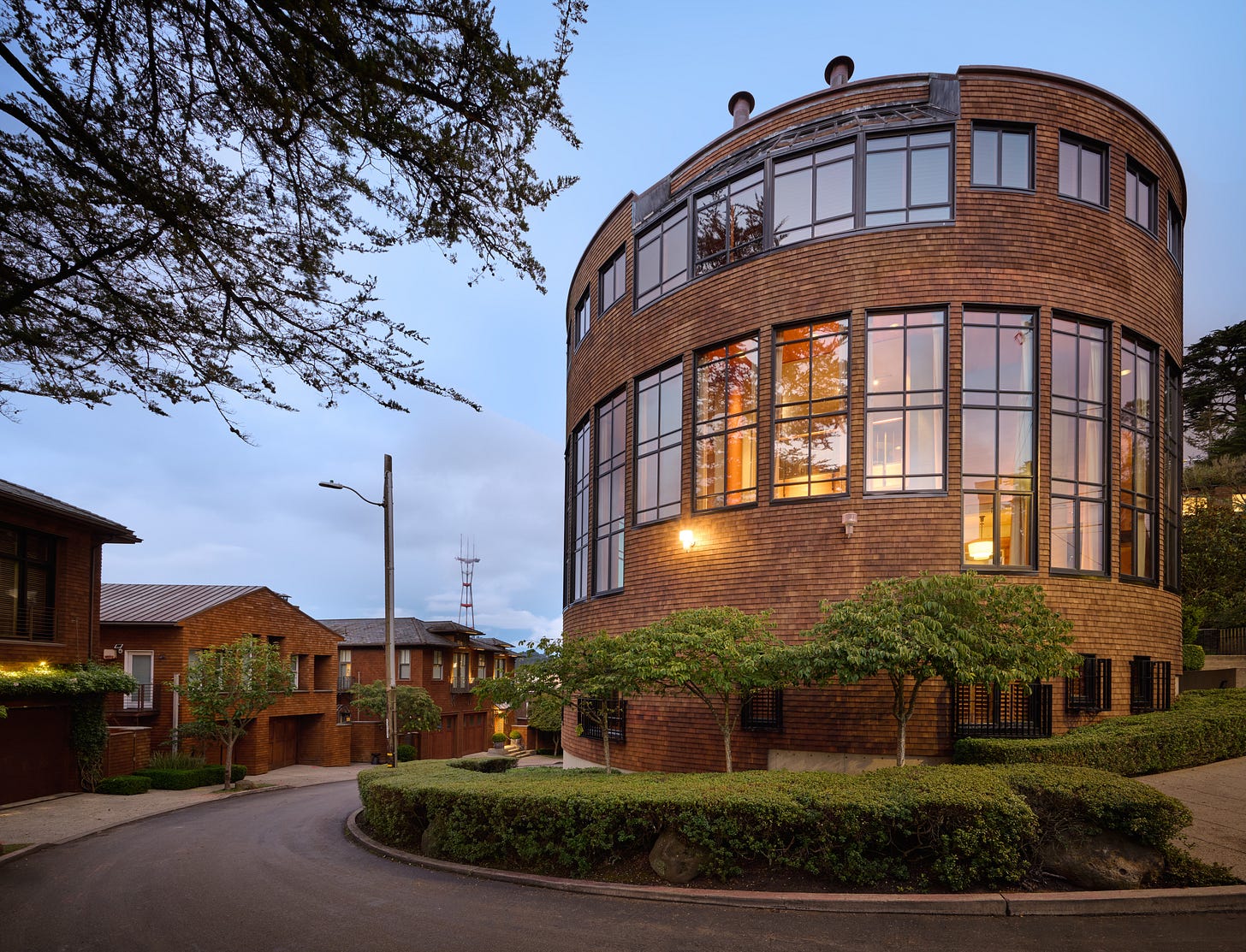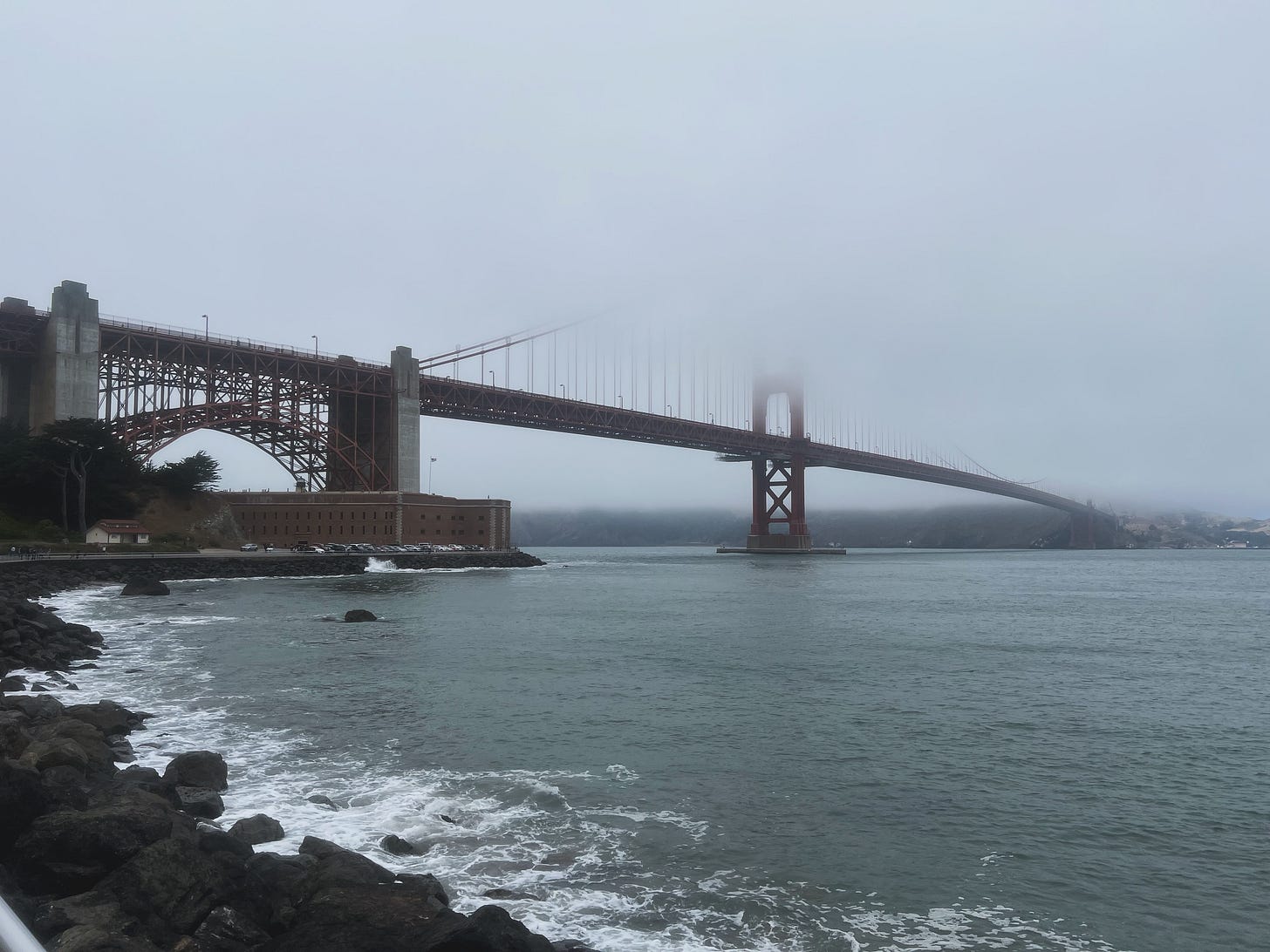What does science tell us about fog?
Hint: It's not your imagination. There really is a lot less of it.
“What a fun read! Clearly someone as obsessed with the city as I am!” - Pledged subscriber
Find us on Instagram: @mustlikefog
Send us TIPS and comments: mustlikefog@substack.com
If you read to the end, there’s a fun reward!
Well hello there. This week I headed up the hill from my home to the Legion of Honor, which offers great art amidst a great view of the Bay. Opened a century ago, in 1924, the structure was a gift of socialite and philanthropist Alma Spreckels, who, upon attending the 1915 Panama-Pacific International Exposition, had been impressed by the replica of the Palais de la Légion d’Honneur in Paris. She and husband Adolph B. Spreckels then committed to giving the city a museum inspired by the Parisian design.
It felt like a mini escape to head high above the city and immerse myself in impressionist art for an afternoon after a very bizarre week. I also found myself downtown for a talk on comedy by the hilarious entertainer Dulce Sloan at SFMOMA. I missed the party for the city’s own literary mag, Zyzzyva, which celebrated its 40th birthday nearby that same night. As these events were taking place, we braced for a threatened surge of federal agents—which was called off after Mayor Daniel Lurie had a late-night phone conversation with the president.
As the city lets out a collective sigh of relief (for now), let’s take a look at what else caught our eye around the Bay Area.
If photography is more your thing, a new show at the De Young documents Northern California’s boom and bust cycles, from the 1800s to 2017.
And if you’re looking for the best Halloween houses in the city, here are some of the best neighborhoods.
Before le heist at the Louvre, thieves reportedly made off with over 1,000 artifacts from the Oakland Museum of California’s off-site warehouse earlier this month. “The suspect(s) broke into the facility and stole more than 1,000 items from the Museum’s collection, including Native American baskets, jewelry, laptops, and other historic artifacts,” according to the Oakland Police Department, which is collaborating with the FBI art crimes department.
And about that housing goal in San Francisco? A new report from the city economist projects that San Francisco will fall well short of its state mandate of 82,000 homes by 2031.
Also, check out this incredible viral video of a rescued dog who fell 40 feet down a cliff at Fort Funston.
This week, we have a very cool contemporary in San Francisco, the first time on the market since it was built in 1970. A scientist tells Must Like Fog all about fog (the good, the bad, and the soggy), and we get some advice on how to keep your pets safe over the holidays. Danger lurks! Read on.
Cool curved contemporary rolls onto the market
A major San Francisco real estate developer’s massive modern mansion has come on the market. The curvy residence was built for Angelo Sangiacomo, the “best-known post-war developer in San Francisco,” according to listing details of the property.
Represented by Neal Ward of Compass, the cool contemporary is on the market for $10 million. “Over the course of my career, I’ve had the fortunate opportunity to represent families of architecturally significant homes,” Ward said in a statement. “This residence stands among the highest expressions of intentional thought, architecture, and design level rarely seen.”
Sangiacomo, who died in 2015, grew up the son of a woodworker in the city, and went on to become “one of the largest landlords in San Francisco’s history,” the listing details note.
Perched on a hill high above the city, the home was commissioned in the late 1960s and designed by the architect Robert V. Arrigoni, co-founder of BAR Architects, and best known for his work on the Lucasfilm campus, Skywalker Ranch.
Completed in 1970, this is the first time the stand-out residence has gone up for sale. It possesses a timeless design that is a perfect fit for the current age.
Located at 111 Edgehill Way, the property spans over 10,000 square feet, with eight bedrooms, eight baths, walls of glass, and soaring ceilings. Other highlights include a wine room, a roof top with 360-degree views, and a four-car garage.
The home offers up an array of mid-century flourishes, including an open floor plan, floor-to-ceiling windows, as well as wood floors and ceilings that soften the rough concrete features. One particular highlight is the 2,000-square-foot lower level basement with a bar and fireplace. A well-placed dining room sits on a mezzanine level that looks both out the window and over the living room, which features soaring 20-feet ceilings.
“”My siblings and I felt so fortunate growing up in this home,” Sandro Sangiacomo, one of Angelo’s six children, said in a statement. “My parents shaped with heart and uncompromising intention the home I grew up in. I remember long dinners in the kitchen and all the fun we had downstairs. Sharing this place now isn’t an ending; it’s a continuation of what they believed in: bringing people together. I hope the next family feels what we felt here and adds their story to the history at 111 Edgehill.”




Is it less foggy out here—or is it just me?
In San Francisco, we usually expect a clear and sunny fall after tolerating a grey and dreary summer. Our city generally has very moderate temps year round, which is a relief in summer months when most of the country is baking under unbearable heat. But those of us who have lived here for years have noticed a subtle but significant change: foggy days seem fewer than they used to be. Homebuyers also have noticed, and have been flocking to neighborhoods once dismissed as fogged-in frontiers.
Old timers remember fog as omnipresent decades ago. And it’s become part of the city’s personality. So much so that the fog even has its own social media account. Back in 2019 I took a look at San Francisco neighborhoods near the ocean, like the Outer Sunset, and Outer Richmond, where buyers had previously been scared away by the grey clouds. But thanks to apparent decreasing amounts of fog and a plethora of single-family homes on the market, those neighborhoods are now hot commodities. Sunset Dunes Park, has quickly become one of the city’s most popular recreation areas, with 30,000 visitors a week. (Despite the success of the park, its own community threw out the city supervisor who championed it.)
While less fog might be great for real estate sales, it isn’t such good news for the redwoods, or in fact any living thing that needs water.
I asked Todd Dawson, a UC Berkeley professor who co-authored a major fog study, to explain what’s happening to our Fog City. This interview has been lightly edited.
Q. What is your name/title/area of expertise?
A. Todd Dawson, Professor of Integrative Biology and Environmental Science, Policy & Management at UC Berkeley. My research focuses on plant ecology and physiology, ecohydrology, and environmental change science.
Q. First of all, what exactly is fog?
A. There are a few types of fog and they form in different ways. But in general, [it] is a saturated air mass that sits right on the ground. In coastal California the marine fog is caused by warm moist air interacting with cold upwelled water from the Pacific Ocean. As the air aloft is cooled from the cold water it reaches what we call the ‘dew point’ and very fine water droplets form right at the surface. Fog layers that form in this way are not very thick (100-400 ft.) and are drawn on shore each night as the land surface begins to cool after a day of heating up and that hot air rises and pulls the fog on to land.
Q. Compared to say, 30 years ago, or even 60 years ago, has fog truly declined, as older locals claim?
“The costal fogs all around the world have all declined over the past 50-75 years. Here in California fog has declined 35+% since 1950 and this continues.”
A. Coastal fogs all around the world have all declined over the past 50-75 years. Here in California fog has declined 35+% since 1950 and this continues. The average summer time fog day in San Francisco has shortened from 12 hours per day to just 9. And many days in summer are now fog-less. This change is linked to both a warmer land surface and sea surface as the Earth has warmed from anthropogenic causes. So the warm air—cold ocean contrast has declined and along with it fog has also declined.
Q. Fewer foggy days seems to be a selling point for people looking to move to homes/neighborhoods by the beach that used to be cold and miserable most of the year, and now, have become quite pleasant. Does that track with what you see in the data?
A. Yes. But less fog also means less fog water that comes on shore every summer and provides the coastal ecosystems with a real water subsidy in an otherwise rainless summer. So coastal ecosystems like the redwood forest are seeing more water deficits and in some areas the trees are suffering as seen by lower growth and thinning tree crowns.
Q. Is climate change to blame for the change in prevalence of fog? Should I feel bad that I’m happy that it’s warmer?
A. Yes. I can’t tell you how to feel. But climate change as we can clearly see from many lines of evidence is not helping us very much. It might be warmer but it’s also drier and with less water comes less of everything else (less water to drink, less water for crops, less water for natural ecosystems, more severe wildfires, more life threatening climatic extremes). Higher costs to humanity and the planet.
Q. Okay, that puts a damper on my joy. Are you looking at what the future holds for foggy weather?
A. Yes—many of us are trying. But climate change is adding many unexpected surprises too. As I mentioned, climatic extremes are becoming the “new normal” with mega-droughts, the worst floods ever recorded, massive hurricanes that wipe out everything in their path, and more. Remote sensing is helping us track some of these changes but it does not work for everything.
Your ad could be here. Support local journalism and place an ad today.
6 tips to keep your pets safe over the holidays
With the countdown to Thanksgiving already revving up, the holiday sprint from Halloween to the New Year starts now, with parties, holiday feasts, and decorations galore. But before you deck the halls, take a quick check to make sure your pets are safe throughout the season.
Must Like Fog got some helpful tips from Michael Hyder, Medical Director, VEG ER for Pets – Palo Alto. VEG ER is a nationwide hospital that treats some 600,000 animals a year. For vets, December is often the busiest time of the year for our furry friends due to all kinds of holiday-related mishaps. Here are six tips to keep in mind, and hopefully, keep Fido and Fluffy out of harm’s way.
Keep candy away from pets: Keep your Halloween stash, candy canes, Hanukah gelt, and baked goods out of pets’ mouths. Feeding them the sweet stuff can make your pet sick or can even be fatal. “Chocolate, xylitol (a sugar substitute), raisins, and alcohol are common holiday hazards for pets,” Hyder says. He recommends keeping candy in secure containers and avoid leaving sweets unattended on counters. And make sure visitors know not to share the loot, “no matter how sweet the begging eyes,” he adds.
Watch out for mushrooms and molds: We’ve had a preponderance of gruesome looking mushrooms sprouting up in our backyard that interested our pup. And apparently we’re not alone, as they pop up on trails, parks, and yes, yards. “Unfortunately, many mushroom varieties in Northern California are toxic to pets and can cause vomiting, liver failure, or worse. Molds, particularly those growing on decaying leaves or mulch, may also produce mycotoxins that are dangerous when ingested.” Keep an eye out, because mushrooms grow more frequently in fall. Try your best to keep your pet away from these toxic substances and visit an emergency vet or call poison control immediately if you see your dog chewing on a wild mushroom, Hyder advises.
Don’t step on a snake! Here’s my worst nightmare: Stepping on a snake. Second worst? My dog walking on one. “Though we associate rattlesnakes with summer, in the fall they often become more aggressive as they prepare to brumate (a hibernation-like state),” Hyder says. “They may be sluggish and more defensive if surprised under brush or on warm trails.” His advice: Stick to well-worn trails and keep dogs leashed when hiking through rocky or thick vegetation. Consider a rattlesnake vaccine or carrying bite first aid with you if you’re frequently out on the trails, Hyder advises.
Pay attention to temperature changes/weather: Heading on a hike? Consider weather swings if you’re taking along your pooch. “In the Bay Area, temperatures can swing quickly between warm afternoons and chilly evenings, especially near the coast or in the hills. Rainy days can also bring muddy conditions and slippery surfaces,” Hyder notes. If it’s cold outside, consider a jacket or rain coat for a smaller breed dog. Booties can also protect paw pads from ground that’s hot, cold, rainy, or muddy.
Be careful around decorations: When holiday decorations go up, it’s a hazard hiding in plain sight. Social media videos show some of the (admittedly hilarious) disasters in waiting: From cats climbing the Christmas tree, to (not very funny) pets drinking the tree water, playing with power cords and holiday lights, gobbling up tinsel, ribbons, tape, and more. In fact, “Toxic plants such as poinsettias, mistletoe, and lilies (for cats) are also holiday hazards, as many pet owners are unaware of the dangers these plants pose,” according to Adam Christman, DVM, MBA. “Clinics frequently see cases of toxic ingestion or injury from decorations during this time.”
Holiday fetes can be hell on pets. If you’re hosting holiday guests (and their pets) make sure to keep guest room doors closed, especially bathroom doors, and secure garbage in pet-proofed bins, such as ones with butterfly lids. Be sure windows and doors are closed — guests can be forgetful! And be mindful that your pets might be stressed out, just like you possibly are. “Creating a quiet, pet-safe space during parties or travel prep can help minimize stress,” Hyder says.
And most importantly, “If you’re ever unsure whether something your pet ate, chewed, or sniffed is dangerous, don’t wait. Contact your veterinarian or reach out to us at VEG ER for Pets,” Hyder says.
And now, here’s your hilarious treat…Enjoy!
Was this newsletter forwarded to you? Please subscribe (and pledge)! You can learn more about Must Like Fog here. We’re not AI! Real humans handcrafted this newsletter just for you. Please support independent journalism!
Big thanks to editor extraordinaire Erik Gunther.






